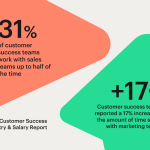- Like
- SHARE
- Digg
- Del
- Tumblr
- VKontakte
- Flattr
- Buffer
- Love This
- Save
- Odnoklassniki
- Meneame
- Blogger
- Amazon
- Yahoo Mail
- Gmail
- AOL
- Newsvine
- HackerNews
- Evernote
- MySpace
- Mail.ru
- Viadeo
- Line
- Comments
- Yummly
- SMS
- Viber
- Telegram
- JOIN
- Skype
- Facebook Messenger
- Kakao
- LiveJournal
- Yammer
- Edgar
- Fintel
- Mix
- Instapaper
- Copy Link
Dear SaaStr: Why would any big business take a risk on a start-up?
They wouldn’t. Unless, the gain way outweighs the risk.
And yet … they do all the time.
If you have a product that (x) uniquely, or in an importantly superior, fashion (y) solves a real, large painful problem for a Big Co … they will buy from a start-up. If their top vendors they use already don’t provide that unique/superior solution.
So how do you create that scenario? How do you get large customers when you don’t have any yet?
A few thoughts, 10 ideas, at least:
- Figure out your 10x feature for large enterprises — and distill it to a headline. What is the top thing you do, that the Big Competitors don’t, that matters to a Big Customer. And that solves a big headache for them. Then, distill that down to a sentence. And put that distillation everywhere.
- Take that 10x Headline Feature — and do targeted outbound and ABM promoting it. Pick 200 folks that really could benefit from it. Don’t ask for coffee. Don’t just spam a list. Instead, take a lot of time and write each of these 200 prospects a personal, short email about how you will solve their big problem. An email that is so powerful, so good — that they’d buy based on that email alone.
- Go to every leading event and meet everyone you can. Put that 10x feature on your T-shirt and business card. Events and trade-shows may seem old school, but the #1 event in each industry and vertical attracts the best of the best. Including buyers.
- Do every bit of press, every podcast you can that even a few prospects might listen to. You have to try to be everywhere your customers might be. That’s hard when you are small. Press, podcasts, etc. help because they give you reach.
- Build on the platforms your target enterprise customers use. Build on Salesforce Appexchange, on Shopify Plus, on Workday, whatever fits. On every open and even partially open platform you can. They aren’t perfect discovery engines. But they do help customers find you.
- Content marketing is slow, but it does work. Write very high-value blog posts. Put content together with only 1 goal — helping your potential customers solve the problem you solve. They’ll Google that problem. Fairly often. A bit more here: Corporate Blogs Always Work. But Only If You Do Them Right. | SaaStr
- Minimize risk by encouraging pilots and small deployments to start. A Fortune 100 company doesn’t want to risk everything with a raw startup. But they might test you out in one small group. Don’t make this hard. Make pilots and small deployments easy. Even if the dollars to start are frustratingly small.
- Ask what problem they most want solved — and just solve it for them. Even if it’s not quite what you do today. If you can get in front a big customer, oftentimes, the Big Vendors won’t solve a particular problem they have. But you have to ask to really learn what it is. If you solve it (ideally, without too much custom work), they may pick you just because you’ll do it and others won’t. The trick of course is to do work you can re-use with the next similar customer. But this usually isn’t that hard. Where there’s 1 customer, there’s almost always 10, and then 100, a lot or just like them.
- Find technology and integration partners. Build webhooks and an awesome API to make it easy on them. Sometimes, a good integration partner can bring you into big deals when your products are super complementary. They may be much smaller than Salesforce or Shopify, but if even just a $10m ARR start-up with amazing enterprise customers will bring you into deals, that can be amazing. A bit more here: The Law of Attach Rates, And Why Partners Can’t Really Move the Needle For You (Directly) | SaaStr
- Start small, and go upmarket over time. Another proven path is to start at the bottom of the market with SMBs. But usually, once you make 1,000 SMBs happy, bigger companies will start to find you, too. You often won’t be ready to serve them yet. But they’ll tell you what they need, and where your feature gaps are. If you listen, and solve those gaps over time … you’ll close the bigger customer leads that come in. Lost of happy SMBs create enterprise leads over time. They write about you, tweet about you, write 5 star reviews about you. And then when BigCos go to do discovery for new vendors in the space, they find you. From the PR the happy SMBs do for you on their own.
Some good lessons on how to going upmarket here from Phil Fernandez, co-founder/founding Founding CEO of Marketo:
(note: an updated SaaStr Classic answer)


